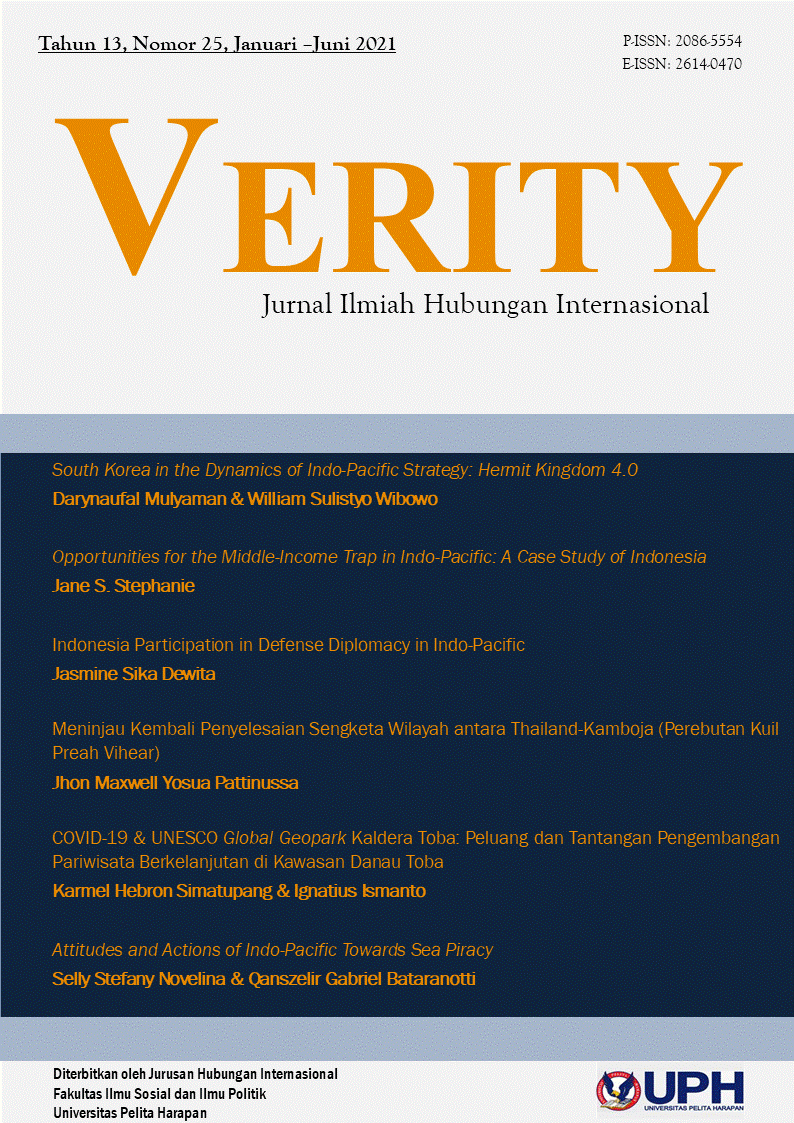MENINJAU KEMBALI PENYELESAIAN SENGKETA WILAYAH ANTARA THAILAND-KAMBOJA (PEREBUTAN KUIL PREAH VIHEAR) [RETHINKING THE TERRITORIAL DISPUTE SETTLEMENT BETWEEN THAILAND-CAMBODIA (CONQUEST FOR PREAH VIHEAR TEMPLE)]
DOI:
https://doi.org/10.19166/verity.v13i25.4468Keywords:
Preah Vihear, Ajudikasi Internasional, Thailand, Kamboja, Sengketa Wilayah InternasionalAbstract
International territorial disputes are still one of the most popular security issues today””for example, the conflict in the border area between Thailand and Cambodia. The two countries fought over the Preah Vihear temple, which was considered a national identity related to national pride. For more than 50 years, the two countries have been at loggerheads, and many lives have been caused due to the conflict. Various parties have tried various approaches and efforts to achieve peace. International adjudication through the International Court of Justice made decisions and solutions to answer these problems in 1962. However, until 2011, international adjudication has not succeeded in resolving conflicts/answering international adjudication issues. This paper aims to identify the existing problems using a qualitative approach by focusing on the two main findings, the dynamics of Thailand's attitude towards the results of international adjudication and how these problems were exploited by Thai populism circles, which ultimately led to the 2011 bloodshed. The author sees that this can be avoided if conflict resolution is balanced with public education, namely improving the social environment and strengthening the bottom-up approach to conflict resolution. Absolute peace and conflict resolution can be realized for both countries.
Bahasa Indonesia Abstract: Sengketa wilayah internasional masih menjadi salah satu isu keamanan paling populer hingga saat ini. Misalnya saja konflik wilayah perbatasan antara Thailand dan Kamboja. Kedua negara memperebutkan kuil Preah Vihear yang dianggap merupakan identitas bangsa dan berkaitan dengan harga diri bangsa. Selama lebih dari 50 tahun kedua negara bersengketa dan sudah banyak korban jiwa ditimbulkan akibat dari konflik tersebut. Beragam pendekatan serta upaya untuk mencapai perdamaian sudah coba dilakukan oleh berbagai pihak. Ajudikasi internasional melalui International Court of Justice membuat keputusan dan solusi untuk menjawab permasalahan tersebut pada tahun 1962. Tetapi sejak saat itu sampai tahun 2011 silam ajudikasi internasional tidak berhasil meredakan konflik/menjawab permasalahan ajudikasi internasional. Tulisan ini bertujuan untuk mengidentifikasi permasalahan yang ada dengan menggunakan pendekatan kualitatif. Dengan berfokus pada dua temuan utama dinamika sikap Thailand terhadap hasil dari ajudikasi internasional dan bagaimana permasalahan tersebut dimanfaatkan oleh kalangan populisme Thailand yang pada akhirnya menimbulkan pertumpahan darah 2011 silam. Penulis melihat hal ini dapat dihindari apabila resolusi konflik diimbangi dengan pendidikan masyarakat yaitu peningkatan social environtment dan penguatan bottom - up approach pada resolusi konflik, supaya perdamaian dan resolusi konflik yang sesungguhnya dapat terwujud bagi kedua negara.
References
Borrell, B. (2013). The Battle Over Preah Vihear A territorial dispute involving a 1,100-year-old Khmer temple on the. Archaeology, 66(2), 53-56. https://www.jstor.org/stable/10.2307/26928682
Ciorciari, J. D. (2014). Request for Interpretation of the Judgment of 15 June 1962 in the Case Concerning the Temple of Preah Vihear (Cambodia v. Thailand). The American Journal of International Law, 108(2), 288-295. https://www.jstor.org/stable/10.5305/amerjintelaw.108.2.0288
Jeong, H. W. (2000). Peace and Conflict Studies: An Introduction. Sydney: Ashgate.
Lamont, C. (2015). Research Methods in International Relations. London: Sage.
Lee, S. K. (2014). Revisiting the territorial dispute over the Preah Vihear temple. South East Asia Research, 22(1), 39-55. https://www.jstor.org/stable/23752499
Menkel-Meadow, C. (2013). The Historical Contingencies of Conflict Resolution. International Journal of Conflict Engagement and Resolution, 32-55. https://www.jstor.org/stable/26928167
Mishra, S. K. (2016). The Colonial Origins of Territorial Disputes in South Asia. The Journal of Territorial and Maritime Studies, 3(1), 5-23. https://www.jstor.org/stable/10.2307/26664123
Ngoun, K. (2012, January 27). Thai-Cambodian conflict rooted in history. Retrieved from https://www.eastasiaforum.org/2012/01/27/thai-cambodian-conflict-rooted-in-history/
Rothman, J., et al. (2014). Correlation of Theory and Practice in Conflict Engagement. Den Haag: Eleven International Publishing.
Saikia, P. (2012). The Dispute over Prea Vihear: Seen Problems, Unseen Stakes. New Delhi: Institute Institute of Peace and Conflict Conflict Studies. http://www.jstor.com/stable/resrep09270
Strate, S. (2013). A pile of stones? Preah Vihear as a Thai symbol of National Humiliation. South East Asia Research, 41-68. https://www.jstor.org/stable/23752586
Tun, K. M. (2011). Case: Disputover Preah Vihear Temple. 7th Berlin conference on Asian Security (BCAS) Territorial Issues in Asia Drivers, Instruments, Ways Forward, Stiftung Wissenschaft tun Politik German Institute for International and Security Affairs (pp. 3-4). Berlin: Sriftung Wissenschaft and Politics.
United Nations. (2013, November 11). UN court rules for Cambodia in Preah Vihear temple dispute with Thailand. Retrieved from https://news.un.org/en/story/2013/11/455062-un-court-rules-cambodia-preah-vihear-temple-dispute-thailand
Wallensteen, P. (2002). Understanding Conflict Resolution: War, Peace and the Global System. London: Sage.
Downloads
Published
Issue
Section
License
Authors who publish with this journal agree to the following terms:
1) Authors retain copyright and grant the journal right of first publication with the work simultaneously licensed under a Creative Commons Attribution License (CC-BY-SA 4.0) that allows others to share the work with an acknowledgement of the work's authorship and initial publication in this journal.
2) Authors are able to enter into separate, additional contractual arrangements for the non-exclusive distribution of the journal's published version of the work (e.g., post it to an institutional repository or publish it in a book), with an acknowledgement of its initial publication in this journal.
3) Authors are permitted and encouraged to post their work online (e.g., in institutional repositories or on their website). The final published PDF should be used and bibliographic details that credit the publication in this journal should be included.


